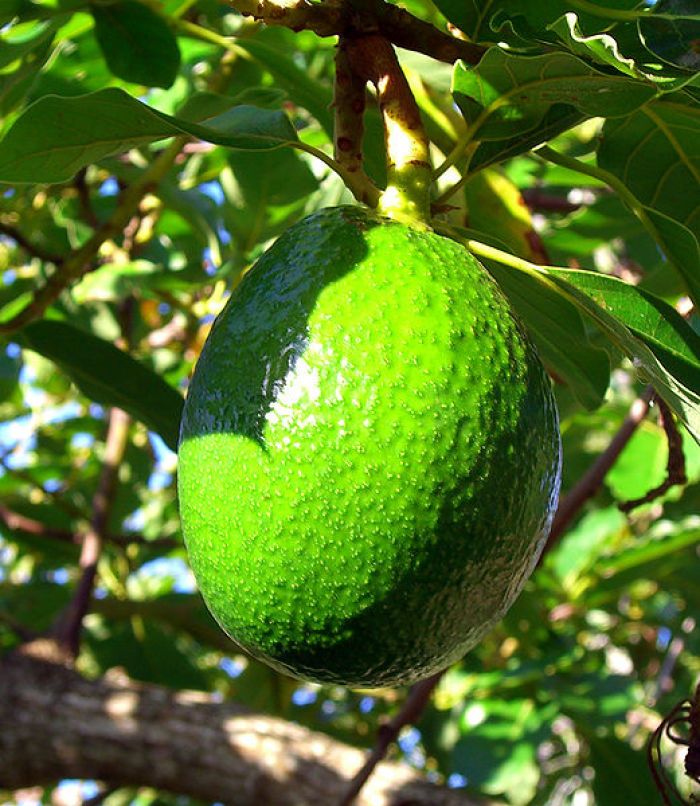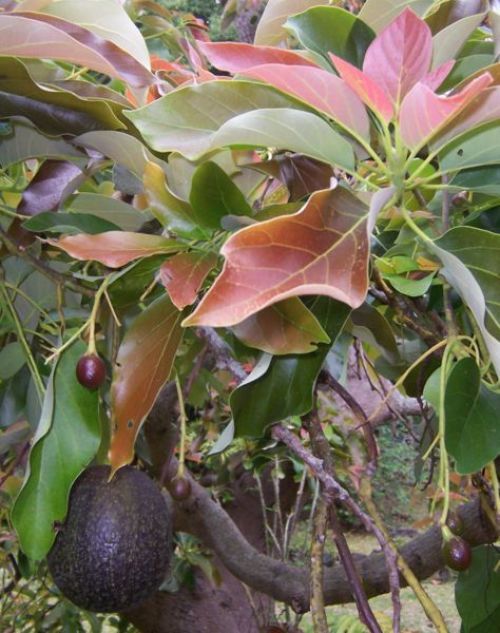
If you just happen to live in zones 9-11, consider growing some delicious avocados (Persea americana). Not only are they tasty, but they offer nutritional value for your heart and eyes due to their 20 vitamins and minerals. You may have hear that avocados are high in fat and oils, but it’s the good kind: mono and polyunsaturated. They’re also a great source of fiber and protein.
All of this goodness comes hanging from a handsome, 15- to 45-foot-tall tree to boot. Avocado trees are broad-leafed evergreens that grow as wide as they are tall, so give them their space. If you don’t live in a zone that stays above about 20 degrees, they can also be grown as houseplants; although they won’t bear fruit.
Before purchasing an avocado tree, you’ll want to find out if the variety is self-pollinating or not as both types are available. You can grow your own avocado tree with the seed-toothpick-glass-of-water trick, but you may end up disappointed as it could take a decade to see any fruit. Commercial avocado trees are grafted onto appropriate rootstock, which moves things along considerably.
Planting and Caring for Avocado Trees
They best months for planting avocado trees are March though June. They need full sun and well-drained soil. If you have soil that just won’t let go of the water, plant your tree on a hill or big raised garden bed. Some growers advise planting it in the soil slightly higher than it was planted in its container. At least be sure it’s the same planting depth—and not deeper. These trees won’t hold up against strong winds, so consider that when choosing a site or the trunck or branches may snap.
Once avocado trees are mature, they’re practically camels. They only need watering every other week and sometimes much less. But while they’re young be sure to water them deeply every week. After planting, add a generous (6-12 inches) of mulch around the base of the tree. Be sure to keep the mulch 6 to 12 inches away from the truck to avoid pest problems. Young trees should be fertilized lightly and mature trees will thank you for a larger application of nitrogen once in the spring and again in the summer.
Pruning Avocado Trees
There’s not much pruning going on with avocados. Usually, it’s limited to removing dead or dying branches. To control the height of the tree, you can pinch off new shoots. Pruning the trees heavily will lower the yield of fruit production, plus exposed trunks can become sun damaged.
Harvesting Avocados
Depending on the variety it can take anywhere from 3 years or more for your tree to bear fruit. Some varieties will bear heavily during a season, only to produce a lighter harvest the next time around. Ripe fruit depends on the same thing. Some varieties are ready in the fall, some in the spring, and then there’s “Haas” which has fruit ripening for six months at a time.
Harvest avocados when the skin color changes and the shiny skin of its youth has dulled. Curiously, avocados won’t ripen on the tree—they do so after they have been picked and sat around for about 7 to 10 days. While you certainly don’t have to harvest the fruit all at once, if they’re left on the tree for too long, their flavor will fade.
When you cut the avocado from the tree branch, be sure to leave a little piece of stem on the fruit. Handle them carefully so they don’t bruise. The average amount of avocados harvested from most trees is between 60 to 150 pounds. But, amazingly, 200 pounds isn’t unusual. You’ll know your avocados are ready for your favorite guacamole recipe when there’s a slight “give” to the skin as you squeeze them.
Potential Problems
The number on thing to be concerned about while growing an avocado tree is root rot. They’re prone, which is why good soil drainage is imperative from the get-go. Symptoms of root rot include the leaves wilting and yellowing. You may notice that there’s no new growth and the avocados will be small. Affected trees can survive many years in this state.
They don’t have many insect enemies but sometimes acquire fungal diseases. Usually, this is due to very high humidity – the fungal climate of choice. To help prevent these types of diseases keep these trees widely-spaced so the sunlight can reach them.
Avocado Varieties
Mexican avocado varieties bear fruit that’s smooth-skinned, green (even when ripe) and pear-shaped. These trees fare much better in the lower temperatures. However, these varieties such as ‘Fuerte’, ‘Bacon’, and ‘Zutano’ don’t travel as easily as the Guatemalan varieties.
The Guatemalan avocados such as ‘Hass’, ‘Gwen’, ‘Reed’, and ‘Pinkerton’ have fruits with pebbled, thick skins and are rounder in shape. They don’t handle frost well, but are much better for handling (shipping) than their Mexican cousins. While most avocados are green when they’re ripe, ‘Hass’ turns nearly black.
California leads the avocado production for the United States; 90% of them are grown in the golden state.



















Comments
Log in or create an account to post a comment.
Sign up Log in